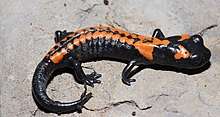Isthmura
Isthmura is a genus of salamanders in the family Plethodontidae. They are endemic to Mexico.[1] The genus, which corresponds to the former "Pseudoeurycea bellii species group" and was first described as a subgenus of Pseudoeurycea, was raised to full generic level in 2015 in order to preserve Ixalotriton and Bolitoglossa while avoiding paraphyly of Pseudoeurycea.[2][3]
| Isthmura | |
|---|---|
 | |
| Isthmura bellii | |
| Scientific classification | |
| Kingdom: | Animalia |
| Phylum: | Chordata |
| Class: | Amphibia |
| Order: | Urodela |
| Family: | Plethodontidae |
| Subfamily: | Hemidactyliinae |
| Genus: | Isthmura Dubois and Raffaelli, 2012 |
| Type species | |
| Spelerpes belli Gray, 1850 | |
| Species | |
|
7 species (see text) | |
Description
Isthmura are large to very large salamanders, and the largest plethodontid salamanders in the Neotropics. They have robust, black bodies that usually have bold red, orange, or pink markings. The toes have slight webbing. The fifth toe is well-developed.[2][4] They inhabit montane forests mostly above 2,000 m (6,600 ft), although Isthmura gigantea and Isthmura maxima have lower minimum altitude limits (respectively 1,000 and 750 m (3,280 and 2,460 ft)).[4]
Species
Isthmura contains the following species:[1][5]
- Isthmura bellii (Gray, 1850)
- Isthmura boneti (Alvarez and Martín, 1967)
- Isthmura corrugata Sandoval-Comte, Pineda-Arredeondo, Rovito, and Luría-Manzano, 2017
- Isthmura gigantea (Taylor, 1939)
- Isthmura maxima (Parra-Olea, García-París, Papenfuss, and Wake, 2005)
- Isthmura naucampatepetl (Parra-Olea, Papenfuss, and Wake, 2001)
- Isthmura sierraoccidentalis (Lowe, Jones, and Wright, 1968)
References
- Frost, Darrel R. (2018). "Isthmura Dubois and Raffaelli, 2012". Amphibian Species of the World: an Online Reference. Version 6.0. American Museum of Natural History. Retrieved 12 February 2018.
- Rovito, Sean M.; Parra-Olea, Gabriela; Recuero, Ernesto & Wake, David B. (2015). "Diversification and biogeographical history of Neotropical plethodontid salamanders" (PDF). Zoological Journal of the Linnean Society. 175 (1): 167–188. doi:10.1111/zoj.12271.
- Frost, Darrel R. (2018). "Pseudoeurycea Taylor, 1944". Amphibian Species of the World: an Online Reference. Version 6.0. American Museum of Natural History. Retrieved 12 February 2018.
- Sandoval-Comte, Adriana; Pineda, Eduardo; Rovito, Sean M. & Luría-Manzano, Ricardo (2017). "A new species of Isthmura (Caudata: Plethodontidae) from the montane cloud forest of central Veracruz, Mexico". Zootaxa. 4277 (4): 573–582. doi:10.11646/zootaxa.4277.4.7.
- "Plethodontidae". AmphibiaWeb: Information on amphibian biology and conservation. [web application]. Berkeley, California: AmphibiaWeb. 2018. Retrieved 12 February 2018.